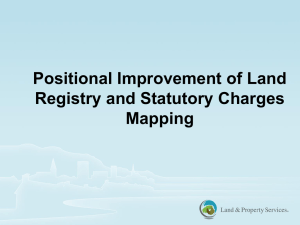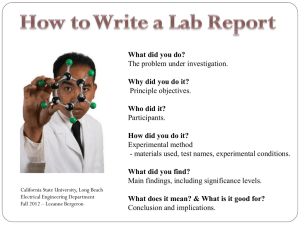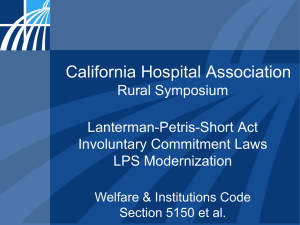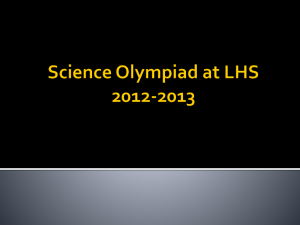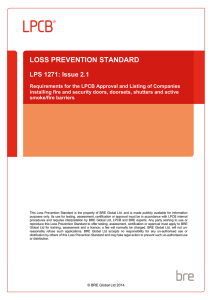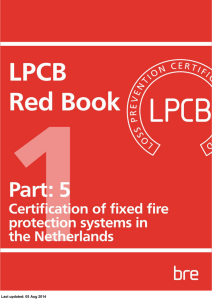BRE LPCB Presentation - Powerpoint File
advertisement
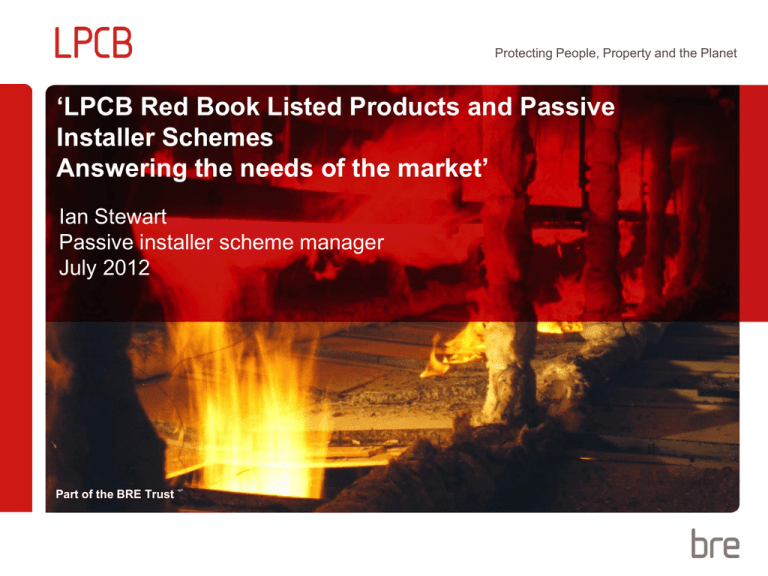
Protecting People, Property and the Planet ‘LPCB Red Book Listed Products and Passive Installer Schemes Answering the needs of the market’ Ian Stewart Passive installer scheme manager July 2012 Part of the BRE Trust Introduction to BRE Global Research, innovation, consultancy, fire testing, certification, related installers, training. Working in the built environment, but also transport, manufacturing, electronics, agriculture… Our national and international standing Customers in 38 countries and recognised in 42 World-class facilities and experts Involved in the development of regulations, codes and standards Advisors on policy One-stop shop for testing and certification Strong links with industry and authoritative bodies So what is Passive Fire Protection? Passive fire protection is the primary measure integrated within the constructional fabric of a building to provide inherent fire safety and protection by responding against flame, heat and smoke to maintain the fundamental requirements of building compartmentation, structural stability, fire separation and safe means of escape. Passive fire protection measures achieve their intended purpose by raising the fire resistance of the structure, protecting the structure against the effects of fire, reducing fire spread through secondary ignition, limiting the movement of flame and smoke, and minimising the danger of fireinduced collapse or structural distortion. Passive fire protection design, incorporating passive fire protection materials, systems and assemblies, serves by fire containment to protect life, safeguard the building structure, protect assets, maintain building serviceability after fire, minimise rebuild costs, and facilitate quick business recovery and continuity In simple terms…..? The ‘fabric’ of the building should be designed, constructed and maintained to reduce or eliminate the spread of fire products around the building. To contain the fire to the area of origin. Protect lives and the structure of the building. Passive Fire Protection Passive Fire Protection Why is passive fire protection so important? Maintains structural stability of steel frame buildings Reduces deflection of floors Maintains compartmentation Reduces spread of smoke Maintains escape routes What happens if it fails? Potential building collapse Potential loss of life Major rebuilding cost Why Passive installer schemes? Reduces the risk of loss of life and product failures by ensuring professional installation Reduces damage caused to property and hence insurance losses should a fire occur Allows installers to comply with AD-B Vol2 Encourages insurers and building control that fire safety has been given appropriate consideration Reduced liability Benefits of Passive installer schemes Reduces risk for manufacturers, end users, insurers, clients, specifiers, contractors, legislators ……… Differentiation for installers Inspection of 15% of installations Installer self certifies his work on LPCB certificates Encourages maintenance of passive via O&M manuals Regulatory Reform order Reduced liability Create a level playing field for installers LPCB Passive installer schemes Installer schemes are available in the form of Loss Prevention Standard (LPS) for the following Passive Fire Protection products :Fire doors (Maintenance and repair) Fire shutters (Maintenance and repair) Smoke barriers (Maintenance and repair) Fire doors (Installation) Security doors (Installation) Fire shutters (Installation) Smoke barriers (Installation) Compartment wall systems (LPS 1208 tested) Penetration, cavity barriers and linear gaps Board fire protection Intumescent coatings Spray fire protection Fire rated ductwork Fire resistant dampers Fire rated compartment walls Offsite applied intumescent coatings LPS 1197 LPS 1197 LPS 1197 LPS 1271 LPS 1271 LPS 1271 LPS 1271 LPS 1500 LPS 1531 LPS 1531 LPS 1531 LPS 1531 LPS 1531 LPS 1531 LPS 1531 LPS 1531 LPS 1531 Issue 1.0 Requirements for the LPCB Approval and Listing of companies installing or applying passive fire protection products This standard defines the requirements for companies installing or applying a generic range of passive fireprotection products. Companies are audited against the standard. Non conformities in line with ISO auditing are issued. A suspension procedure is in place to police the scheme. LPS 1531 Installer scheme specifically for the installation of the following passive fire protection products or systems. Appendix: 1. Penetration, cavity barriers and linear gap seals 2. Fire rated board and cladding to structural elements 3. Intumescent coatings to structural elements 4. Fire rated spray materials 5. Fire rated ductwork systems 6. Fire resisting dampers 7. Fire resistant compartment wall systems 8. Offsite application of intumescent coatings to structural elements Fire Stopping Stone mineral wool batt and mastic systems. Fire Stopping Batt and mastic Graphite sealant Intumescent coatings Cellular beams Hollow section steel Fire rated ductwork and dampers Pre coated fire rated duct system. Fire damper anchored inside drywall. Technical issues – fire dampers Technical issues – fire rated ducts Technical issues - penetrations in drywalls How would you fire seal this? Technical issues – use of PU foams Comments? Technical issues – chiller pipe penetrations Summary of LPS 1531 A technical site inspection scheme audited by LPCB inspectors. Improved standards of passive fire protection product installation. Each contract is inspected and signed off by a nominated installation company employee. Installers certify their work with a numbered LPS1531 Certificate of Conformity Site surveillance inspection by LPCB on up to 15% of installations. LPS1531 certification can be invaluable in complying with Regulation 38 of the Building Regulations 2011. This regulation requires the installation company to provide fire safety information to the responsible person. LPS 1197 : Issue 3.0 Requirements for the LPCB Approval and Listing of companies Undertaking the Maintenance and Repair of Doorsets, Shutters and Active Smoke/Fire Barriers This standard defines the requirements for companies inspecting, maintaining and repairing fire doors, fire shutters and smoke/fire barriers. Training to service the specific product. Follow minimum service requirements in LPS1197. All doors, firedoorsets, smoke barriers and smoke/fire barriers shall be inspected and a work programme drawn up. Issue of a Maintenance Certificate. Fire resistant shutters Summary of LPS1197 A technical inspection, maintenance and repair scheme audited by LPCB inspectors. The LPCB approved company can self certify their work against LPS1197. If the Regulatory Reform (Fire Safety) Order 2005 (RRO) applies then the competent person may use an LPS1197 approved installer to carry out regular maintenance to demonstrate compliance with Paragraph 17 - Maintenance, in the RRO. Technical issues 1. Gaps around fire doors and fire and smoke doors. 2. Ensure performance criteria are met. LPS 1271 : Issue 1.0 Requirements for the LPCB Approval and Listing of companies installing fire and security doors and shutters and smoke barriers This standard defines the requirements for companies installing fire and security doors and shutters and fire/smoke barriers. Training to install the specific product. Any doorset or shutter shall have a defined security resistance and be certified or approved by the LPCB or similar certification body. Any doorset or shutter with a defined fire resistance and be certified or approved by the LPCB or similar certification body. The installer shall be in possession of the latest installation instructions for the product being installed. Follow recording requirements in LPS1271. Issue Completion Certificate on all contracts. Fire resistant doorset Steel door 60 minutes Technical issue - door frames Fire sealing around door frames? Summary of LPS1271 A technical installation scheme audited by LPCB inspectors. The LPCB approved company can self certify their work against LPS1271. LPS1271 certification can be invaluable in complying with Regulation 38 of the Building Regulations 2011. This regulation requires the installation company to provide fire safety information to the responsible person. Technical issues 1. Fire sealing around door frames. 2. Ensure performance criteria are met. BRE Passive inspection service An independent third party site inspection can: Provide confidence to all interested parties that the Passive Fire Protection has been installed correctly and in accordance with the manufacturers recommendations. Confirm that the choice of products is suitable for the application. Ensure that the workmanship is of a standard that ensures the fire protection will meet the design specification. Inspection is best carried out at an early stage during installation thus enabling the sub-contractor to have the opportunity to rectify any problems rather than impact on the critical path of the construction. The Red Books Products and services approved by us are listed in the Red Books • Volume 1 Fire Detection and Alarm products and services. Related installers. • Volume 2 Passive fire protection products and services. Security protection systems. Related installers. Management systems. Construction products. • Available on-line at www.redbooklive.com • CD and hard copy Simple guides to installing and inspecting passive fire protection – Good Building Guide GBG 81 – Presents basic information – Directs the reader to more comprehensive documents ASFP & HVCA Guides Thank you for your attention BRE Global answering the needs of the market Ian Stewart Passive installer scheme manager July 2012

